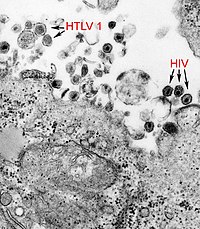
Photo from wikipedia
Background Human T-lymphotropic virus type 1 (HTLV-1)-associated myelopathy (HAM) is a neuroinflammatory disease, causing various neurological symptoms, including motor, sensory, and bladder and bowel dysfunctions. This study was designed to… Click to show full abstract
Background Human T-lymphotropic virus type 1 (HTLV-1)-associated myelopathy (HAM) is a neuroinflammatory disease, causing various neurological symptoms, including motor, sensory, and bladder and bowel dysfunctions. This study was designed to reveal the impact of HAM and related symptoms on health-related quality of life (HRQoL). Methods We analyzed the Short Form-36 (SF-36) and clinical data of 538 patients with HAM registered in the HAM-net, a nationwide patient registry for HAM in Japan. HRQoL was evaluated using the SF-6D (a health state utility value calculated from the SF-36) and eight SF-36 subscales. A general liner model was used to estimate the impact of major HAM-related symptoms, including gait dysfunction, sensory disturbance in the legs (pain and numbness), urinary dysfunction, and constipation, on the SF-6D and SF-36 subscale scores. Results The mean age and disease duration were 62.0 and 16.5 years, respectively. Of the patients, 73.2% needed walking aid; 42.7 and 67.1% had leg pain and numbness, respectively; 92.1% had urinary dysfunction; and 77.9% had constipation. The mean SF-6D score was 0.565, which was significantly lower than the national average (0.674 in the 60–69 years age group; p < 0.001), exceeding the minimal important difference (0.05–0.1). All the major symptoms were significantly associated with a decrease in the SF-6D score. The SF-36 subscale scores were significantly lower than the national standard of 50 (p ≤ 0.001), except for mental health (MH). Gait dysfunction was associated with lower scores in physical functioning (PF), limitations on role functioning because of physical health, bodily pain, general health perception (GH), vitality (VT), and social functioning; however, no association was observed between gait dysfunction and limitations on role functioning because of emotional problems and MH. Meanwhile, sensory disturbance in the legs was associated with a decrease in scores in all subscales. Urinary dysfunction was associated with worse PF, GH, VT, and MH. Constipation was associated only with PF. Conclusion HRQoL of patients with HAM was worse than that of the general population and was associated with all major symptoms. Thus, patients should be comprehensively managed to achieve better HRQoL.
Journal Title: Frontiers in Medicine
Year Published: 2022
Link to full text (if available)
Share on Social Media: Sign Up to like & get
recommendations!